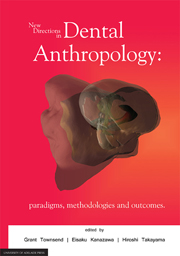Book contents
- Frontmatter
- Foreword
- Contents
- 1 Modelling the complexity of the dentition
- 2 New approaches to dental anthropology based on the study of twins
- 3 Genes for teeth — drawing inference from family data
- 4 Do feeding practices, gestation length, and birth weight affect the timing of emergence of the first primary tooth?
- 5 Sexual dimorphism in the primary and permanent dentitions of twins: an approach to clarifying the role of hormonal factors
- 6 Dental crown and arch size in Europeans and Australian Aboriginals
- 7 Sex determination from maxillary and mandibular canines of the Filipino population
- 8 Non-metric dental characteristics in Papua New Guinea Highlanders and their association with molar reduction
- 9 The Main Occluding Area between opposing teeth during chewing: a comparison between Australians and Japanese
- 10 “Mineral Maintenance” of dental structures in caries and erosive tooth wear: an holistic model
- 11 Emerging techniques for the analysis of tooth wear
1 - Modelling the complexity of the dentition
Published online by Cambridge University Press: 05 May 2013
- Frontmatter
- Foreword
- Contents
- 1 Modelling the complexity of the dentition
- 2 New approaches to dental anthropology based on the study of twins
- 3 Genes for teeth — drawing inference from family data
- 4 Do feeding practices, gestation length, and birth weight affect the timing of emergence of the first primary tooth?
- 5 Sexual dimorphism in the primary and permanent dentitions of twins: an approach to clarifying the role of hormonal factors
- 6 Dental crown and arch size in Europeans and Australian Aboriginals
- 7 Sex determination from maxillary and mandibular canines of the Filipino population
- 8 Non-metric dental characteristics in Papua New Guinea Highlanders and their association with molar reduction
- 9 The Main Occluding Area between opposing teeth during chewing: a comparison between Australians and Japanese
- 10 “Mineral Maintenance” of dental structures in caries and erosive tooth wear: an holistic model
- 11 Emerging techniques for the analysis of tooth wear
Summary
ABSTRACT
The major components and phases of development needed to form a mature dentition are identified and outlined. This information is then examined against the general characteristics of Complex Adaptive Systems. It is concluded that the dentition in development and maturity has the characteristics of a Self Adaptive and Self Organising Complex System. This exploration provides the basis for future investigations of this model.
INTRODUCTION
The dentition, both in development and in maturity, is an intricate system of multiple interacting components. But is it a complex rather than a complicated system? We consider a Complex System to be a dynamic system in which interacting components at a lower level give rise to higher level emergent phenomena, whereas in a complicated system the various elements maintain a degree of independence from one another. Fortunately, in examining this question about the dentition there is much hard data now available concerning the molecular, cellular, soft tissue and mature mineralised components. The aim of this paper is to examine key characteristics of the dentition in development and its mature form against the characteristics of a Complex Adaptive System. Our method is to:
Identify and outline the major components and phases of development of the dentition into a mature functioning system.
Examine this information against the recognised general characteristics of Complex Adaptive Systems.
- Type
- Chapter
- Information
- New Directions in Dental AnthropologyParadigms, Methodologies and Outcomes, pp. 1 - 9Publisher: The University of Adelaide PressPrint publication year: 2012
- 5
- Cited by



